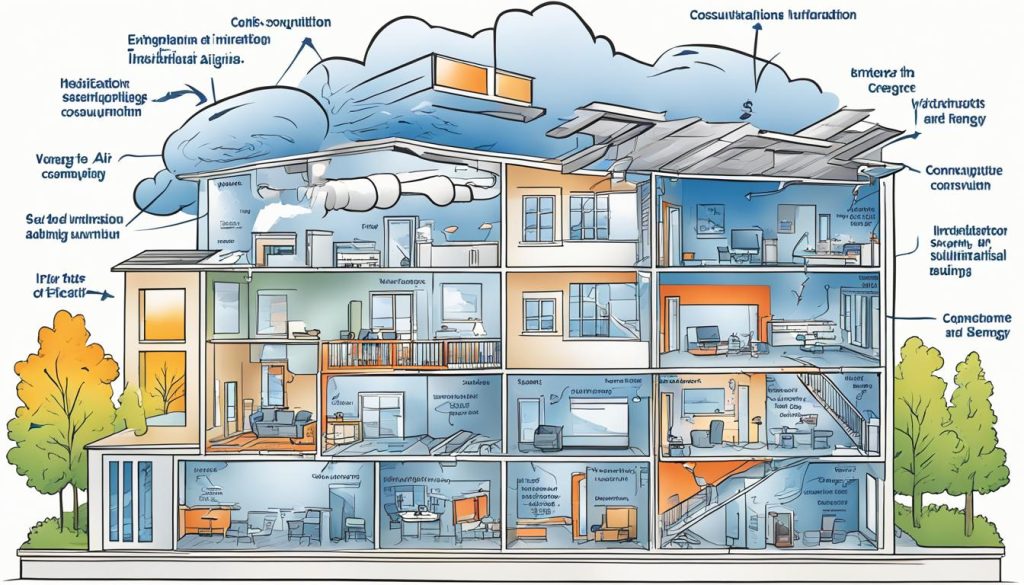To do Manual J calculations, follow a step-by-step guide to find out your home’s heating and cooling needs. This method, from the Air Conditioning Contractors of America (ACCA), is key for the right HVAC system size and saving energy.
Manual J is the core of figuring out your home’s HVAC needs. It looks at your home’s location, climate, direction, and insulation to find out your peak heating and cooling loads. This way, you pick the right HVAC unit that fits your comfort needs and saves energy.
To do Manual J calculations, you need to collect info about your home’s layout, check the climate, and look at how heat and loss happen. This sets the stage for the next steps in designing your HVAC system, like picking equipment (Manual S) and sizing ducts (Manual D).
Learning Manual J calculations helps you design an HVAC system that’s comfortable and energy-efficient. This guide will show you how to do accurate cooling and heating load assessments for your home.
Understanding the Importance of Manual J Calculations
Manual J calculations are key to making your HVAC system work better. They help design systems that keep your home comfortable and save energy. Let’s see why these calculations are so important for your home’s energy use.
Defining Manual J and Its Role in HVAC Design
ACCA Manual J is a method to figure out what your home needs for heating and cooling. It looks at your home’s size, insulation, windows, and the local weather. This helps calculate how much heating and cooling your home requires.
Benefits of Accurate Load Calculations
Getting the load calculations right means your HVAC system is the right size. This avoids problems like short cycling or not controlling the temperature well. A correctly sized system uses less energy, cuts down your bills, and makes your equipment last longer.
Impact on Energy Efficiency and Comfort
Manual J calculations affect your home’s energy use and comfort. A system designed with these calculations keeps temperatures steady everywhere in your home. It stops hot or cold spots and manages humidity well.
| Aspect | With Manual J | Without Manual J |
|---|---|---|
| System Size | Properly sized | Often oversized |
| Energy Efficiency | Optimized | Reduced |
| Comfort | Consistent | Inconsistent |
| Humidity Control | Effective | Poor |
| Equipment Lifespan | Extended | Shortened |
Using Manual J calculations in your HVAC design makes sure your system fits your needs. It improves comfort and saves energy in your home.
The ACCA Manual J Process Overview
The ACCA Manual J process is key for figuring out your home’s HVAC needs. It helps find out how much cooling and heating your home needs. This makes sure your home stays comfortable all year.
First, measure your home’s size. This is the base of your HVAC calculation. Then, check how well your home is insulated. Good insulation affects how much heating and cooling you need.
Next, think about how you use each room. A kitchen, for instance, heats up more than a bedroom. This affects your overall HVAC needs.
- Measure square footage
- Inspect insulation
- Determine space usage
- Assess BTU values
- Calculate total load
Then, look at the BTU values for things in your home. This includes windows, appliances, and people living there. Each thing adds to the heat gain or loss in your home.
Your local weather is also important for HVAC calculations. Things like sunlight, average temperatures, and humidity affect your heating and cooling needs.
The last step is figuring out your total HVAC load. This uses all the data to find the best system size for your home. A system that’s the right size is efficient and keeps you comfortable.
Essential Tools and Resources for Manual J Calculations
For HVAC contractors, doing Manual J calculations right is key. You need the right tools and resources for accuracy. Let’s look at what you need for load calculations to go smoothly.
Manual J Software Options
Load calculation software makes the job easier. It helps HVAC pros get accurate results. Here are some top choices:
- Wrightsoft Right-J
- Elite RHVAC
- ACCA Approved MJ8
- CoolCalc
These programs are easy to use and have lots of features. They help improve your HVAC services.
Required Data and Documentation
To do Manual J calculations well, you need certain info:
- Building plans and blueprints
- Insulation details for walls, floors, and ceilings
- Window specs
- Local climate data
- Occupancy info
Training and Certification Considerations
Getting the right training is crucial. It helps you use software and understand results better. Look into these certifications:
- ACCA Manual J Certification
- NATE Heat Load Analysis Certification
- BPI Building Analyst Certification
Training and certification boost your skills and trustworthiness in HVAC services.
| Resource | Purpose | Importance |
|---|---|---|
| Load Calculation Software | Automate calculations | High |
| Building Data | Input for calculations | Critical |
| Certification | Ensure expertise | Recommended |
Gathering Building Information for Load Calculations
To get the right HVAC system size, you must collect detailed building info. This is key for figuring out how much cooling and heating your home needs. Let’s look at what you should gather.
First, measure your home’s square footage. This means all living areas, basements, and attics. Then, check the insulation types and R-values in walls, floors, and ceilings. These affect how well your home keeps heat in or out.
Look at how your home faces and the windows you have. Note their size, type, and where they are. Windows let in sunlight, which can heat your home. Also, think about appliances and lights inside that add to the heat.
Essential Building Information Checklist
- Square footage of all living spaces
- Insulation types and R-values
- Building orientation
- Window sizes, types, and locations
- Internal heat sources
- Roof type and color
- Number of occupants
- Ceiling heights
If you have them, use blueprints or construction plans for more info. These can tell you a lot about your home’s design and materials.
| Building Component | Impact on Load Calculations |
|---|---|
| Insulation | Affects heat transfer through walls and ceilings |
| Windows | Influences solar heat gain and heat loss |
| Orientation | Determines exposure to sunlight and prevailing winds |
| Internal Heat Sources | Contributes to overall cooling load |
With all this info, you’re ready for Manual J calculations. This ensures your HVAC system is the right size. It makes your home more comfortable and saves energy.
Assessing Climate Data and Design Conditions
Climate is key in HVAC design for better home energy use. You must look at local weather and design conditions closely. This means understanding climate zones, setting design temperatures, and thinking about humidity levels.
Understanding Climate Zones
The U.S. has eight main climate zones, each with its own HVAC needs. Knowing your zone helps with insulation, ventilation, and choosing the right equipment size. For instance, homes in hot, humid areas need cooling solutions different from those in cold, dry places.
Determining Design Temperatures
Design temperatures are vital for the right HVAC system size. They are the highest and lowest outdoor temperatures your system must handle. For cooling, it’s the 1% summer temperature. For heating, it’s the 99% winter temperature. This ensures your system works well during extreme weather without being too big.
Factoring in Humidity Levels
Humidity greatly affects comfort and energy use. High humidity makes spaces feel hotter and can cause mold. Low humidity leads to static and dry skin. Your HVAC should consider your area’s humidity levels. This might mean adding dehumidifiers in humid areas or humidifiers in dry ones.
| Climate Factor | Impact on HVAC Design | Energy Efficiency Consideration |
|---|---|---|
| Temperature Extremes | Determines required heating/cooling capacity | Proper sizing prevents energy waste |
| Humidity Levels | Influences moisture control needs | Efficient humidity management reduces energy use |
| Seasonal Variations | Affects system operation periods | Seasonal adjustments optimize energy consumption |
By carefully looking at these climate factors, you can design an HVAC system that boosts comfort and saves energy at home. This way, your system works great all year, no matter the weather outside.
Evaluating Building Envelope Characteristics
When figuring out an HVAC load, it’s key to look at the building envelope. This includes walls, roof, windows, and doors that keep the inside and outside separate. These parts greatly affect how much cooling and heating your home needs.
Insulation is a big deal for keeping heat from moving through the building. Buildings with good insulation use less energy for heating and cooling. Make sure to check the R-value of insulation in walls, attics, and floors. A higher R-value means better insulation.

How airtight a building is also matters a lot. Gaps and cracks let air in, making the HVAC work harder. Use a blower door test to find and fix air leaks.
Thermal bridges, like metal studs or not well-insulated spots, can let heat get through insulation. Find and fix these spots to make your heating and cooling more efficient.
| Building Component | Impact on HVAC Load | Improvement Strategies |
|---|---|---|
| Windows | High heat gain/loss | Double-pane, low-E glass |
| Walls | Moderate heat transfer | Add insulation, seal air leaks |
| Roof | Significant heat gain | Reflective roofing, attic ventilation |
| Doors | Air leakage points | Weatherstripping, proper sealing |
Looking closely at these envelope parts helps you figure out your home’s HVAC needs. This way, you can design a system that works just right for you.
Calculating Heat Gain and Heat Loss
Getting the right size for your HVAC system and improving your home’s energy efficiency starts with understanding heat gain and loss. These are key to designing your home’s HVAC system well. Let’s look at what affects heat transfer in your home.
Conduction through Building Materials
Heat flows through your home’s walls, roof, and floors. The speed of this flow depends on the materials used. Insulation helps slow down heat flow, making your home more energy efficient. Think about adding insulation in important spots to ease your HVAC system’s work.
Solar Radiation Effects
The sun’s rays can change your home’s temperature. Windows let sunlight in, warming up your home. This can be good in winter but bad in summer. By placing windows right and using shades, you can control the sun’s effects.
Internal Heat Sources
Your home also heats up from inside. Appliances, lights, and people add to the heat. It’s important to consider these sources when figuring out your HVAC system’s size.
Knowing these factors helps make a detailed heat load profile for your home. This profile helps pick the right HVAC system size. It ensures you stay comfortable and save energy.
| Heat Transfer Factor | Impact on HVAC Sizing | Energy Efficiency Considerations |
|---|---|---|
| Building Material Conduction | Affects overall heat loss/gain | Proper insulation reduces energy needs |
| Solar Radiation | Increases cooling load in summer | Window treatments can minimize impact |
| Internal Heat Sources | Contributes to heating load | Energy-efficient appliances reduce heat generation |
Factoring in Infiltration and Ventilation Rates

Infiltration and ventilation are key in HVAC design. They can change your cooling and heating loads a lot. Air leaks or mechanical systems can increase your HVAC load by up to 30% or more.
To figure out infiltration rates, check your home’s air tightness. Look for gaps around windows, doors, and openings. Sealing these spots can cut down on air leaks and boost energy efficiency.
Ventilation is vital for good indoor air quality. Think about both natural and mechanical systems when calculating loads. Balanced ventilation helps control humidity and eases the load on your HVAC.
| Factor | Impact on Cooling Load | Impact on Heating Load |
|---|---|---|
| High Infiltration | Increased load in summer | Increased load in winter |
| Proper Ventilation | Reduced load, better air quality | Slight increase, improved comfort |
Getting infiltration and ventilation rates right can make your HVAC system work better. This means more energy efficiency, cleaner air, and more comfort at home. Always talk to a professional HVAC designer for the best calculations for your home.
Perform Manual J Calculations for Residential HVAC Design
Learning ACCA Manual J calculations is key for designing efficient HVAC systems for homes. This method makes sure your heating and cooling systems fit just right. It leads to better energy use and more comfort. Let’s explore the steps, common mistakes, and how to understand Manual J calculations.
Step-by-step Calculation Process
To do Manual J calculations for the best HVAC design, follow these steps:
- Gather building info like size, insulation, and window types
- Look at local climate and design conditions
- Calculate heat gain and loss for each room
- Consider infiltration and ventilation rates
- Add up the total heating and cooling needs
Common Pitfalls and How to Avoid Them
Be careful of these mistakes when doing Manual J calculations:
- Wrong measurements of the living areas
- Missing thermal bridging in the building’s envelope
- Wrong insulation R-values
- Forgetting about internal heat sources (appliances, people)
To dodge these errors, double-check your measurements, use the latest insulation info, and include all heat sources in your calculations.
Interpreting and Applying Calculation Results
After your Manual J calculations, use the results to:
| Result | Application |
|---|---|
| Total cooling load (BTU/h) | Pick the right air conditioner size |
| Total heating load (BTU/h) | Find the correct furnace or heat pump size |
| Room-by-room loads | Plan ductwork and figure out register sizes |
By using these tips, you’ll be ready to do accurate Manual J calculations. This ensures your HVAC systems work well, making your home efficient and comfortable.
Integrating Manual J with Manual S and Manual D
Manual J is the first step in designing a great HVAC system. But it’s not enough on its own. You also need Manual S and Manual D to make your home comfortable and efficient.
After Manual J, it’s time for Manual S. This manual helps pick the right HVAC equipment for your home. Choosing the right size and type is key to avoid problems that make your system work less well.
Manual D is the last piece of the puzzle. It uses info from Manual J and S to design your ducts. This ensures your HVAC system sends air efficiently to every room. Together, these manuals make sure your system works well as a whole.
Using all three manuals, HVAC contractors can design a system just for you. This approach is key to a comfortable and energy-saving home all year.





0 Comments